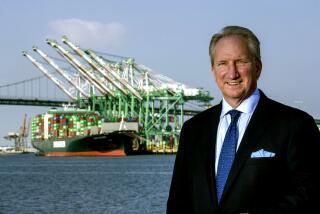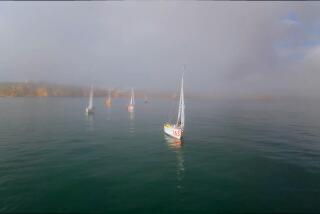Boatyard Owners Bid for Cup Race
- Share via
Boatyard owners are pressing the San Diego Unified Port District to forgo construction of new boatyards if the America’s Cup is defended in San Diego, and instead house as many as 18 sailing syndicates in San Diego’s privately operated boatyards.
Additionally, owners of the 15 boatyards that ring San Diego Bay want to modify their facilities to accommodate the massive and potentially lucrative spectator boat fleet that would be drawn to San Diego if the San Diego Yacht Club defends the Cup in its own backyard.
Boatyard owners argue that the Port District could trim the public costs associated with a Cup defense by at least $9 million if private boatyards provide the space and maritime services for the expected 18 to 20 racing syndicates.
The port, however, has yet to determine what it would cost to provide new docks and work areas for sailing syndicates. Port officials will not determine what kind of facilities will be necessary until a committee formed by the San Diego Yacht Club determines where the Cup defense will be staged.
The boatyard owners’ concern was prompted in part by the possibility that the port--like Fremantle, Australia, which was host to the 1986-87 Cup defense--might build new facilities that would remain in business after the race.
“The port doesn’t have the facilities to make (the Cup defense) a slam dunk” unless it uses existing boatyards that build, repair, service and store sailing and motorized yachts, according to John Sawicki, who operates a Coronado boatyard.
The use of existing boatyards that lease space from the port also would lessen any environmental impact on San Diego Bay and trim the number of state and federal environmental and land-use permits that must accompany new facilities, Sawicki said.
“You’d almost have to start today to plan for getting all the permits . . . that you’d need, and you’d still barely finish in time to have something up . . . particularly if it’s a waterfront business,” according to Tom Fetter, president of Kettenburg Marine.
In Australia, syndicates were housed in new facilities that were carved out of an under-used section of the Fremantle harbor, according to Fetter, who visited Australia before the Cup races began. “In San Diego, there is an alternative to creating new facilities, and that’s tucking the syndicates into existing facilities,” he said.
Boatyard owners are forwarding proposals to the Port District staff detailing what each individual yard sees as its role in a Cup defense. But a formal presentation will be made only if San Diego is chosen as the host city.
The city’s boatyard owners met for the first time early in February, partly in response to suggestions by other would-be host cities that San Diego lacks the maritime facilities needed to present the world’s premier sailboat race.
“We felt a bit on the defensive after hearing that kind of talk,” acknowledged Shelter Island boat builder Jerry Driscoll, who recently acted as general manager for the Newport Beach-based Eagle 12-meter syndicate in Australia. “We have what it takes and we’re ready, so (talk) that we don’t have the facilities . . . is a bunch of b.s.”
“Nobody can accuse San Diego of not being 100% ready now because we’ve passed the biggest hurdle--we’ve got all the boatyards working together,” said Sawicki. “We’re ready to go get an armlock on the decision-makers at the yacht club.”
Port District Director Don Nay last week described the boatyard owners’ proposal to accommodate the lion’s share of sailing syndicates as being “in line with our general philosophy of letting private enterprise do it. We’re glad they’re getting together.”
The boatyard owners’ Cup bid also is designed to prevent the Port District from building “a whole bunch of (boatyards) that would end up as competition for them after the race is done and gone,” Nay said.
“There isn’t enough business to go around now,” agreed Sawicki, chairman of Coronado-based Marine Engineering & Services, who wants assurances that if new facilities are built, the port “would lease any new (boatyard) areas at the same rate they lease to us.”
Surprisingly, although boatyard owners believe they will benefit economically from the dramatic rise in boating that is likely to be generated by a Cup defense, they don’t describe the syndicates as a potentially lucrative source of revenue.
“You might cover your costs, but (housing a syndicate) isn’t the best way to turn a buck,” according to Driscoll, who in addition to operating Driscoll’s Custom Boats, has served as skipper, boat builder, trainer or general manager in half a dozen America’s Cup campaigns. “There’s not a lot of money to be made.”
“Nobody’s going to get rich enough to walk away from the business,” Sawicki said. “But it’s a neat way to supplement your business . . . during the five or six months of winter when a lot of private yachts aren’t taken out.”
“The bottom-line benefit to people employed in the boat repair, service and support functions is that there would be a tremendous increase in (boating) interest and usage,” according to Fetter.
Boatyard owners agreed that yard capacities would be boosted by the anticipated influx of visiting yachts. In addition to smaller craft, the host city would have to make dock space available to massive, ocean-going yachts of up to 150 feet in length.
“In Fremantle, they had about 3,200 spectator boats out for the race,” said Sawicki, who wants to redesign his eight-acre Coronado boatyard to handle spectator boats. “Then you include Newport Beach, Marina del Rey, San Francisco, and you easily can see 10,000 to 12,000 spectator boats--and that’s not including the 8,000 from San Diego. It’s going to be ‘Nelly, bar the door.’
“This may sound trite, but the Cup (would make) San Diego recession-proof, especially with the new convention center open,” Sawicki said. “Wintertime travel will be at a premium.”
More to Read
Sign up for Essential California
The most important California stories and recommendations in your inbox every morning.
You may occasionally receive promotional content from the Los Angeles Times.










